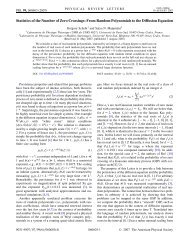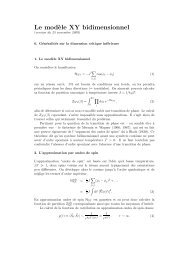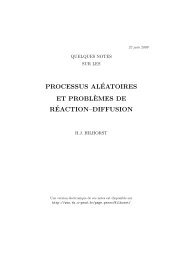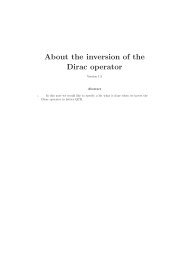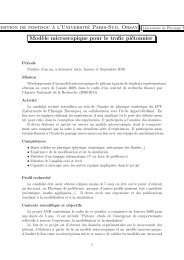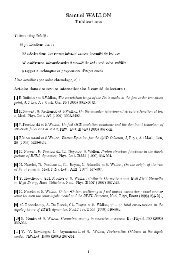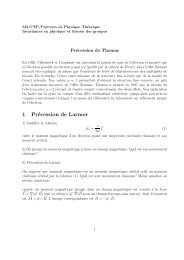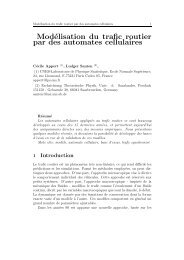Andrea Shindler
Andrea Shindler
Andrea Shindler
- No tags were found...
Create successful ePaper yourself
Turn your PDF publications into a flip-book with our unique Google optimized e-Paper software.
The chiral regime ofQCD<strong>Andrea</strong> <strong>Shindler</strong>Dynamics of QCD at very small up/down quark massSpontaneous breaking of chiral symmetryCombination of lattice QCD & chiral perturbation theoryDetermination of low energy constantsTowards a microscopic understanding of chiral symmetryAnalysis of spectral density of Wilson operatorMonday, January 17, 2011
QCD and chiral symmetryQCD vacuum is not chirally symmetricGoldstone theoremG → H ⇒ N = N G − N H massless particlesSU(2) L × SU(2) R → SU(2) V ⇒ 3Goldstone bosons (3 pions)Pions are not massless becauseM = 0Chiral symmetry is useful ifMis smallm q Λ QCD 250 MeV (m q 4MeV )M π Λ χ =4πF π 1.2 GeV (M π 140 MeV )Chiral symmetry can be used to write a generic effective theorySide remarkm s Λ QCD /2 ∼ 100 MeVM K Λ χ /2 ∼ 500 MeVMonday, January 17, 2011
Goldstone boson fieldsDifficult step: construct the effective theoryU(x) ∈ SU(2) U → V L UV † Runder SU(2) L × SU(2) RAnyU =0breaksSU(2) L × SU(2) R → SU(2) VFluctuations areπfieldsU(x) =e iπ/F π(x) =3π a (x)τ aa=1Write most general Lagrangian withU, U † , M, M †chirally symmetricOrder terms using power countingp 2 /Λ 2 χ ∼ M/Λ QCD(p-expansion)M = O(p 2 )1L = O(p)Monday, January 17, 2011
Chiral LagrangianL (2)χ = F 24 Tr ∂ µ U(x) † ∂ µ U(x) − Σ 2 Tr[M† U(x)+MU(x) † ]Two low energy constants (LECs)ΣandFShould beF ∼ Λ QCDandΣ ∼ Λ 3 QCDL (2)χ= 1 4 Tr [∂ µπ∂ µ π]+ mΣ2F 2 Tr π 2 ,⇒ M 2 π =2 Σ F 2 mmp 2χPT gives us the (and ) dependenceBut Σ and F are unknownCompute with lattice QCD themdependenceMonday, January 17, 2011
Matching QCD to ΧPTCompute numericallyO QCDat low energy and small massesCompute analyticallyO χat LO, NLO, NNLO,...CompareO QCDandO χSSB is the correct mechanismUnderstand the low energy dynamic of QCDm q p 2Compute LEC and/or , dependencePheno relevance:B K ,K → π,K → ππ, Form FactorsLarge activity in the lattice QCD communityNeed to control all systematic errors of the lattice QCD computationLattice simulations are always done in a finite volumeNeed to stay in large volume to control FSEUsually one needs to simulate large volumes but...Volume can be used to probe the theoryMonday, January 17, 2011
Infrared divergencesG(x) = 1 Vpe ipxp 2 + M 2 π= 1VM 2 π+ 1 Vp=0e ipxp 2 + M 2 πCorrelation lengthM −1πlarger than the size of the boxWhere is the problem?→d 4 xL (2)χ = −2mΣV +U(x) =e iφ(x) Fd 4 2x4 Tr [∂ µφ∂ µ φ] − mΣ2 Tr φ 2 ,Torus⇒periodic plane wavesφ(x) = n,ac a nτ a e (2πi) n µxµLn =0 m =0The mode does not show up if integral is not GaussianMonday, January 17, 2011
egime in the continuumThe leading term in the effective action readsGasser,Leutwyler: 1987d 4 xL (2)χ = − ΣmV Tr U † 0V2+ U 0 ,Z = D [U 0 ]e ΣmV2Tr[U † 0 +U 0]¯qq¯qq ∞The partition function is given by an integral over a group manifoldThe order parameter, vanishes in the chiral limit at fixed finite volumeR =Monday, January 17, 2011
MotivationsImportant tool to understand the chiral limitFinite temperature computationsSome quantities have less contaminations from higher ordersLO and NLO chiral Lagrangian has only 2 LECs ( )Can be used to compute electroweak couplingsCan be used to study the microscopic properties of QCDIt is alternative and complementary to standard large volume simulationsto determine LECsWhy is not so popular?FΣMonday, January 17, 2011
Lattice simulationsChiral symmetry and topology play a relevant rÔle in this regimeLeutwyler,Smilga:1992Common lore was: use overlap (chirally symmetric) and fix topologyResults obtained with overlap fermions (huge computational effort)New approach: use Wilson-type fermions and average over alltopological sectorsJansen, Nube, A.S., Urbach, Wenger:2007Monday, January 17, 2011
S = a 4 xWilson-type fermionsS = a 4 xψ(x)γ µ12∇µ + ∇ ∗ µ +e−iωγ 5 τ 3 − 1 2 ∇ µ∇ ∗ µ + m cr+ m Pψ(x)ψ(x) =e iωγ 5 τ32 χ(x)ψ(x) =χ(x)e iωγ 5 τ32critical mass 1χ(x)2 γµ ∇µ + ∇ ∗ µ −∇µ ∇ ∗ µ + mcr + m q + iµ q γ 5 τ 3 χ(x)untwisted massm q = m P cos ωµ q = m P sin ωm P = m 2 q + µ 2 1/2qtwisted masspolar massMonday, January 17, 2011
Lattice simulations in theregimeProblem 1: instabilities at low quark masses with Wilson fermionsSolution 1: use Wilson twisted mass fermionsDel Debbio, Giusti, Lüscher, Petronzio, Tantalo: 2006Problem 2: metastabilities issues at small twisted massETMC: 2004-2006Solution 2: in a regime with no SSB there should be no problemProblem 3: need an algorithm to simulate in this extreme regimeSolution 3: combine PHMC with exact reweighingJansen,Nube,A.S.,Urbach,Wenger: 2007Jansen,Nube,A.S:2008Problem 4: understand cutoff effectsSolution 4: GeneralizeχPT to include lattice artefactsA.S.:2008Bär, Necco, Schaefer: 2008Bär, Necco, A.S.:2010Monday, January 17, 2011
Simulation detailsA.S.: in progressaµ q N trajlattice β size a (fm)I 3.9 16 3 1× 32 0.085 0.0005 2500I 3.9 16 3 2× 32 0.085 0.00075 3500I 3.9 16 3 3× 32 0.085 0.001 3135F 14.05 24 3 × 48 0.067 0.00039 1755F 4.05 24 3 2× 48 0.067 0.00078 2316F 34.05 24 3 × 24 0.067 0.00078 2500F 4 4.05 20 3 × 40 0.067 0.00039 2500β =4.0520 3 × 40aµ q =3.9 · 10 −4Monday, January 17, 2011
Pseudoscalar correlation functionC P (x 0 )= Σ2 eff3X2 (z eff )X 1 (z eff ) + 3F 2 1 − 1 3X 2 (z) T1(τ)X 1 (z) L 3 hΣ eff = Σ1 − N f 2 − 1N f F 2 Ḡ(0)z =2mΣVMonday, January 17, 2011
WilsonχPTContinuum Symanzik action (effective theory)L eff = L + aL 1 + ...Develop a generalized chiral expansion for the Symanzik effective theorySharpe, Singleton: 1998L (2)W χ = F 24 Tr ∂ µ U(x) † ∂ µ U(x) − Σ 2 Tr MU(x) † + M † U(x) + a W 0F 2Tr U(x) † + U(x) ,2m R → m R + aW 0 F 2 /Σ ≡ m χExtend W PT to the regimeMonday, January 17, 2011
Power countingA.S; Bär, Necco, Schaefer:2008Bär, Necco, A.S.: 2010AokiTransition regionGSM* regimeGSM regimeMonday, January 17, 2011
GSM regimeNo cutoff effects at LO (reabsorbed in the definition of the mass)L (4)W χ= L (4)χ + a W Tr(∂ µ U † ∂ µ U)Tr(U + U † ) − 2aB 0 W Tr(M † U + U † M )Tr(U + U † )+− a 2 W Tr(U + U † ) 2− 2aB0 H Tr(M + M † )No cutoff effects at NLOWilson fermions are “effectively” free from discretization errors up to NNLOcorrectionsMonday, January 17, 2011
Aoki regimeCutoff effects O(a^2) already at LOL (2)W χ = F 24 Tr ∂ µ U(x) † ∂ µ U(x) − Σ 2 Tr M † U(x)+M U(x) † − a 2 W Tr U(x)+U(x) † 2Consequences of different vacuum structureAoki scenario: different pattern of SSBSharpe-Singleton scenario: No zero modes no need for resummationNeed more thoughts and workMonday, January 17, 2011
Transition regionA.S; Bär, Necco, Schaefer: 2008a =0.08fm L a= 24 m =6MeVLeading orderS (0)2 =S (0)2M+S (0)2∂π→S (0)2M= − Σ 2d 4 xTrM † U 0 + U † 0 M ,S (0)2∂π= 1 4d 4 xTr [∂ µ ξ(x)∂ µ ξ(x)]Next-to-leading orderZ = Nd [U 0 ]e − S (0)2M(Σ eff )× Zπ [U 0 ]Z π [U 0 ]=N1+W a 2 V 2Tr U 0 + U † 2aW ΣV0 +F 2TrM † U 0 + U † 0 M TrU 0 + U † 0 ,Monday, January 17, 2011
Wilson twisted mass in the ε regimeL = F 24 Tr ∂ µ U(x)∂ µ U † (x) − Σ 2 Tr M † U(x)+U † (x)M ,M = m1 + iµ q σ 3 = m P e iω 0σ 3 m P = iU = U 0 expF ξa σ a ,m 2 + µ 2 qBär, Necco, A.S: 2010O = 1 ZD [U] O [U]e −S χ[U]The ground state U VU = U V U 0 exp iF ξa σ a D [U] =d [U 0 ] D [ξ] A (ξ)The Haar measure d [U 0 ] is invariant d [U 0 ]=d [U V U 0 ]The ground state of Wilson fermions does not play a special rôle in the ε regimeBecause of the integration over the zero-modes one does not need to find thevacuum angleMonday, January 17, 2011
Wilson twisted mass in the ε regimeAt finite lattice spacingg (U 0 ) = 1 Z 0SU(2)d [U 0 ] g (U 0 )e z m2Tr[U 0 +U † 0]−i z µ2 Tr [σ 3 (U 0 −U † 0)]z m = mΣVz µ = µ q ΣVFor z µ =0 we obtain modified Bessel functionsFor z µ =0 it looks superficially rather differentWe change basis and use the invariance of the Haar measureg (U 0 ) = 1 Z 0SU(2)dU0gW U 0 We z 2 Tr U0 + U 0† ≡gW U 0 W physwithW =e i ω 02σ 3 z = m P ΣVThe ω 0 dependence will be traded with a m PCAC dependenceMonday, January 17, 2011
Pseudoscalar correlation functionC 11PP(x 0 ) = C 11PP(x 0 )| cont +A.S.: in progressρΣ 224z 5 I 1 (2z) 2 4z m z 2 2µ + z m I 1 (2z) 3 − z z 2 2µ + 11z m I 2 (2z) I 1 (2z) 2 +I 2 (2z)+ 2 −2z m 4 +3z m 2 + z µ2 1 − 2z m2 I 2 (2z) 2 I 1 (2z)+z z µ 2 +5z m2 I 2 (2z) 3 ,Monday, January 17, 2011
Effective couplingsr 0 Σ 1/3 =0.595(12), r 0 F =0.224(12) [P RELIMINARY ]Monday, January 17, 2011
Systematic errorsGroup N f r 0 Σ 1/3This work 2 0.595(12)ETMC (2009) 2 0.575(19)HHS (2008) 2 0.617(15)JLQCD[1] (2007) 2 0.596(10)JLQCD[2] (2007) 2 0.624(17)(27)Group N f r 0 FThis work 2 0.224(12)ETMC(2007) 2 0.182(6)HHS (2008) 2 0.224(10)JLQCD[1](2007) 2 0.217(14)Neglected higher order correction (≈ 8 %)Discretization errors (≈ 4-8%)Monday, January 17, 2011
Conclusions and future plansProbe the ε regime with Wilson type fermions is possibleAnalytical tool to study (a,m,V) dependenceComputed 2-point functions at NLONumerical simulations in the ε regime with WtmPHMC with exact reweighingExtraction of LECs (Σ, F) w/o contaminations from chiral logsFull understanding of systematic uncertainties to be completedHigher order corrections in χPT (≈ 8%)Discretization errors (≈ 4-10%)Enlarge set of simulation pointsEnlarge physical quantities to analyzeThe analytical tool can have other interesting uses:Extension to other lattice actionsChange power counting in the quark mass ...Monday, January 17, 2011
Spectral densityConsiderable algorithmic improvements for Wilson-like fermionsat small quark massesHasenbusch: 2003; Lüscher:2004-2007; Urbach,Jansen,A.S., Wenger:2005Spectral observables can be used to compute relevantquantitiesGiusti, Lüscher:2009 Theoretical understanding of spectral density of WilsonoperatorCutoff effects and FSE distort the spectral densityWilson χPT is the tool to analyze these aspectsMonday, January 17, 2011
Spectral densityAverage spectral density of iD forρ D (γ,m) ≡ limV →∞1Vδ (γ − γ k )kBanks-Casher relationρ D (γ,m)= Σ π [1 + O({|γ|,m}/Λ QCD)]Relation is still valid with GW fermionsCan be used to determine the chiral condensateShape of SD close to the threshold is a useful informationMonday, January 17, 2011
Spectral density of Wilson operatorQ m = γ 5 (D W + m) =Q † mRenormalization[ρ Q ] R(λ,m R )=Z P ρ Q (Z P λ,m)Improve the action + O(am)Mode number: average # of eig. between Λ 1 and Λ 2ν(Λ 1 , Λ 2 ,m)=V Λ2Λ 1dλρ Q (λ,m), Λ 2 ≥ Λ 1 ≥ mν R (Λ 1,R , Λ 2,R ,m R )=ν(Λ 1 , Λ 2 ,m)Mode number: useful to determine the chiral condensateMonday, January 17, 2011
Spectral density in χPTAdd a valence twisted doublet¯χ v γ 5 τ 3 χ v = ∞−∞dλ ρ Q(λ,m)+ρ Q (−λ,m)λ + iµ vDisc ¯χ v γ 5 τ 3 χ v | µv =iλ =2iπ [ρ Q (λ,m)+ρ Q (−λ,m)]In the continuum one needs a single valence quark[ρ Q (λ,m)] NLO =2Σλπ √ 1+λ 2 − m 2Σ(4π) 2 F 4− π λ 2 − m 2 ++ m(3¯l 6 − 1) + 2 √ λ2λ 2 − m 2 − marctan2m Σ|λ|2Σ √ λ− 2m lnF 2 µ 2 − m ln2 − m 2F 2 µ 2 ,+Stern,Smilga:1993; Osborn, Toublan, Verbaarschot:1999Monday, January 17, 2011
Computational schemeWe work in the p and GSM regimeNecco, A.S.: 2010m, µ v ,a∼ O(p 2 ), 1/L, 1/T ∼ O(p)Two methods: replica method, SUSY methodSU(4|2) x SU(4|2) → SU(4|2) M = diag( m 2×2 sea,m+ iµ v τ 3 ,m+ iµ v τ 3 ) 2×2 val 2×2 ghostVacuum corrections computed using a saddle point expansionComputeP 3 NLOand analytically prolong the twisted mass to the complex planeCompute the discontinuity along the imaginaryµ vMonday, January 17, 2011
Spectral density of Wilson operator[ρ Q (λ,m)+ρ Q (−λ,m)] NLO =2Σλπ √ 1+ m2 ˜∆λ 2 − m 2 λ 2 − m 2 ++ m(3¯l 6 − 1) + 2 λ 2 − m 2 arctan−2m ln Σ|λ|2Σ √ λF 2 µ 2 − m ln2 − m 2F 2 µ 2Σ(4π) 2 F 4 − π λ 2 − m 2√ λ2 − m 2m+ 16âF 2 W 6 ,˜∆ = 16â F 2 W 6 + 2âW 6 Mss2 ,∆ = − 16â W8F 2 2 + W 104 + âW 8 Mss2 .Necco,A.S.:2010Monday, January 17, 2011
Finite volume effectsBlack solid lineL =2.56 fm,T=3.84 fm,Red dashed lineL =1.92 fm,T=3.84 fmΣ = (275 MeV) 3 , m=m PCAC = 26.5MeV, F = 90MeV, ¯l6 =5, µ = 139.6MeVMonday, January 17, 2011
Monday, January 17, 2011Mode number
Monday, January 17, 2011Parameter space
Conclusions and future plans (2)Computed in WχPT the spectral density of Wilson operatorGood description of numerical data away from thresholdFull understanding of spectral density to be completedBehaviour at the thresholdMonday, January 17, 2011



